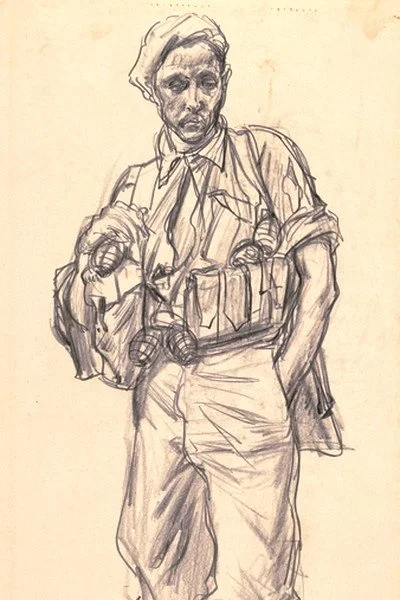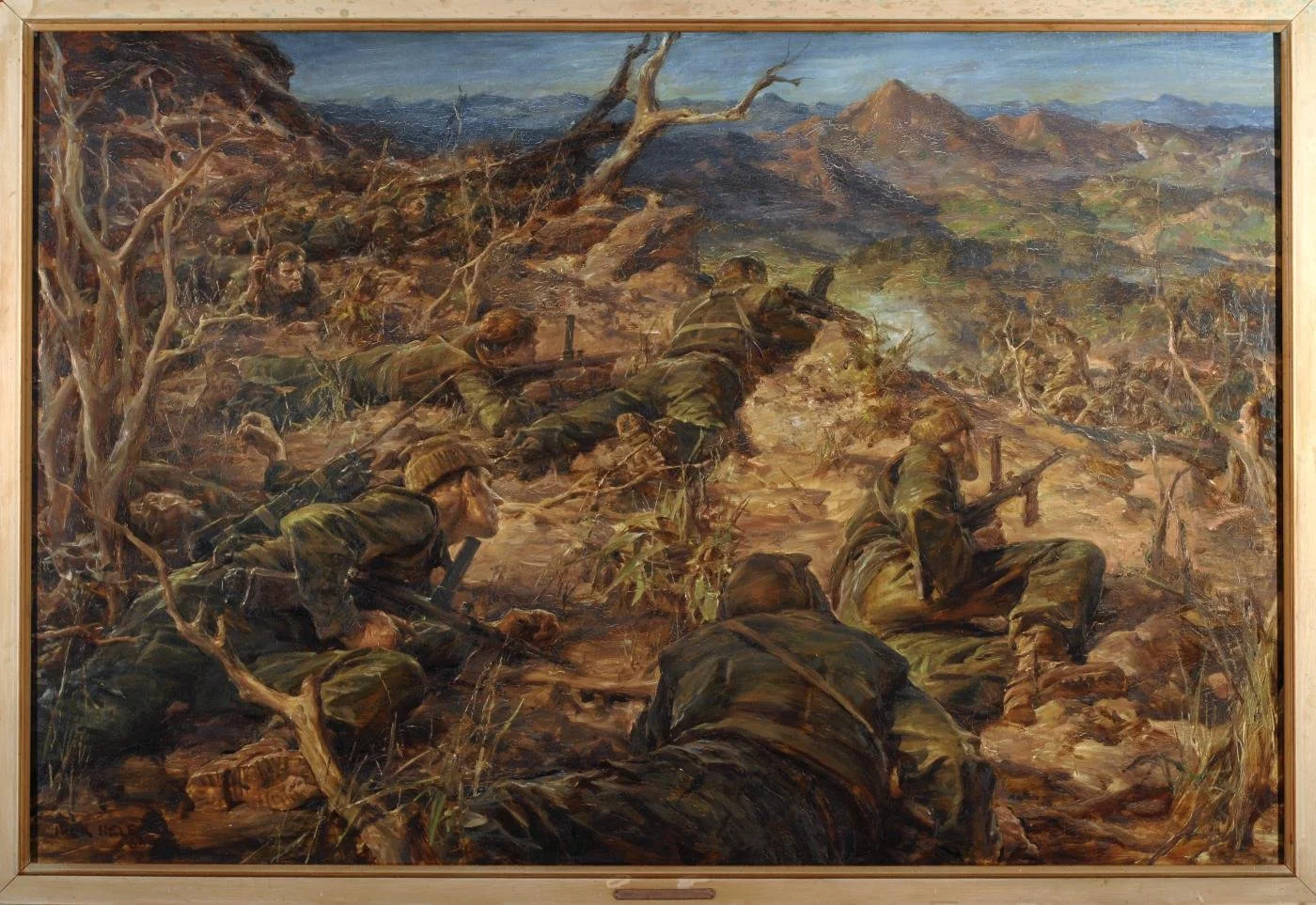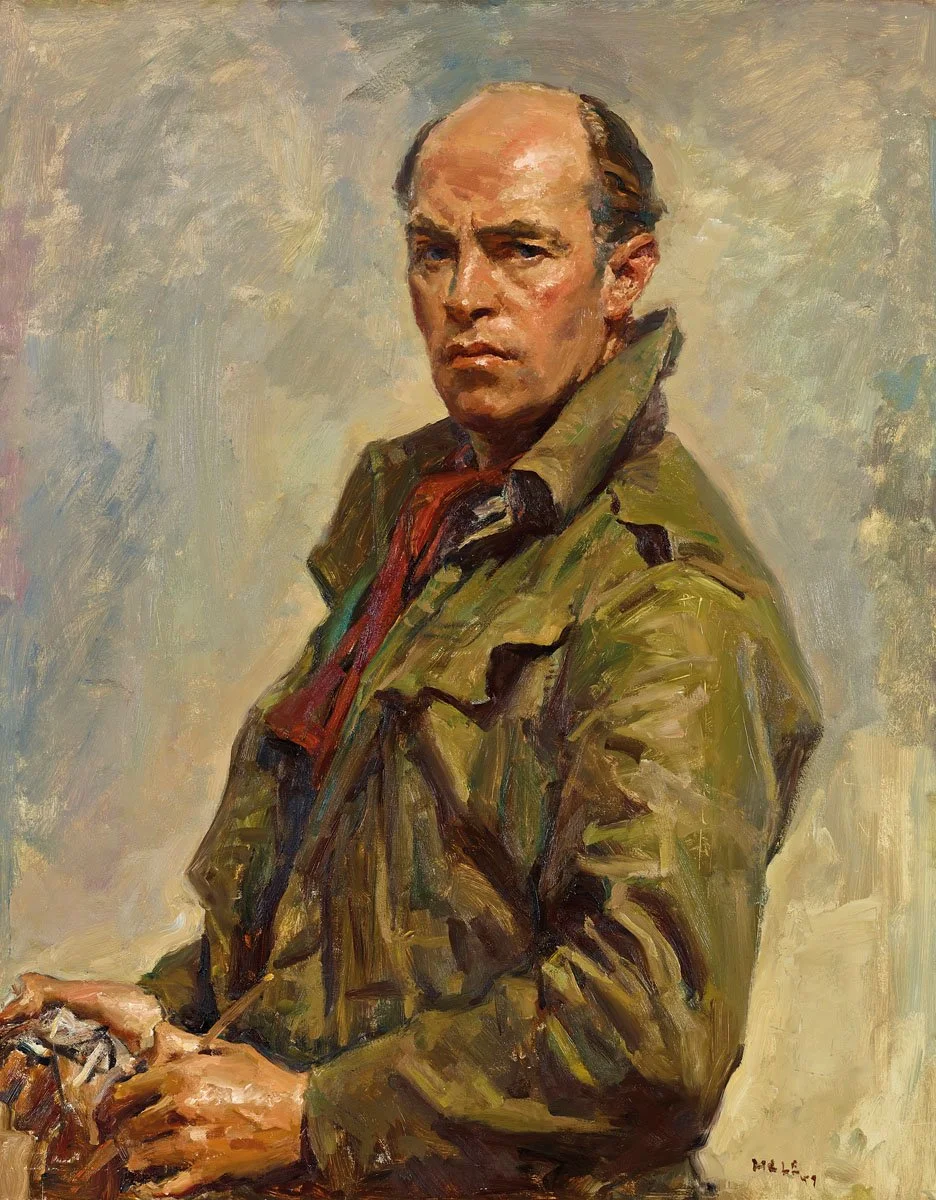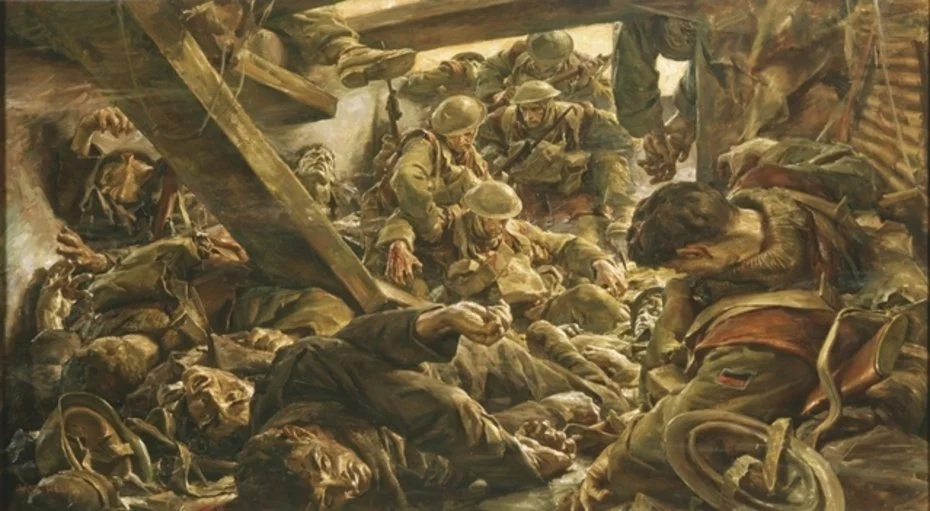Ivor Hele - Self Portrait
Ivor Hele, an Australian war artist, is celebrated for his powerful and evocative depictions of the human experience during times of conflict. Through his artworks, Hele captured the raw emotions, struggles, and heroism of those involved in war, leaving behind a significant artistic and historical legacy.
Early Life and Artistic Beginnings:
Ivor Hele was born on June 13, 1912, in Adelaide, South Australia. From a young age, he displayed a keen interest and talent in art, which led him to pursue formal training at the South Australian School of Arts and Crafts. He further honed his skills at the School of Fine Arts in Adelaide and later studied at the prestigious Julian Ashton Art School in Sydney.
War Service and Artistic Contributions:
With the outbreak of World War II, Ivor Hele enlisted in the Australian Army in 1942 and served as an official war artist. He was attached to the Australian Imperial Force's (AIF) 2/6th Armoured Regiment and later the Royal Australian Air Force (RAAF). Hele's role as a war artist was to document the experiences of Australian servicemen and women through his artwork.
Hele's artistic contributions during the war were invaluable. His sketches, drawings, and paintings captured the harrowing realities of conflict, conveying the physical and emotional toll it took on individuals. Hele's works depicted scenes from various theaters of war, including the Middle East, New Guinea, and the Pacific. He paid particular attention to the human aspect of war, highlighting the camaraderie, sacrifice, and resilience of the soldiers and civilians he encountered.
Ivor Hele's artistic talent and dedication did not go unnoticed. His artworks were widely acclaimed and recognized for their exceptional skill and emotional depth. He received numerous awards for his war art, including the Archibald Prize in 1946 for his portrait of General Sir Thomas Blamey, the Commander-in-Chief of the Australian Military Forces during World War II.
After the war, Hele continued to produce artworks, exploring various themes and subjects beyond war. He became a highly regarded portraitist, capturing the likenesses of prominent Australian figures, including politicians, artists, and intellectuals. His portraits were celebrated for their meticulous detail and psychological insight.
Ivor Hele's contributions to Australian art and the preservation of the nation's wartime history are immeasurable. His artworks serve as poignant reminders of the human experiences and sacrifices made during times of conflict. Today, his paintings and sketches can be found in numerous public and private collections, including the Australian War Memorial in Canberra, where his war art is showcased, providing future generations with a visual narrative of Australia's wartime past.
Ivor Hele, the Australian war artist, left an indelible mark on the art world and the historical documentation of war. Through his keen observational skills and artistic talent, Hele captured the essence of the human experience during times of conflict, leaving behind a rich and emotive body of work. His dedication to portraying the realities of war and his ability to convey the courage and resilience of those involved make Ivor Hele's contributions invaluable in preserving the stories and memories of Australia's wartime history.
The painting "Taking Old Vickers Position, Bobdubi Ridge, 28 July 1943" by Ivor Hele is a significant artwork that captures a moment of intense action during World War II. Created by Hele, an Australian war artist, the painting depicts a critical battle scene from the New Guinea campaign.
The painting portrays Australian soldiers from the 2/16th Infantry Battalion engaging in combat as they assault the enemy positions on Bobdubi Ridge on July 28, 1943. Bobdubi Ridge, located in the rugged terrain of the Finisterre Range in Papua New Guinea, was a strategic objective in the Kokoda Track campaign.
Taking Old Vickers Position, Bobdubi Ridge, 28 July 1943 - Ivor Hele
Taking Old Vickers Position, Bobdubi Ridge, 28 July 1943
In the artwork, Hele skillfully captures the chaos, intensity, and danger of the battle. The composition is dynamic, with soldiers in various states of action, firing their weapons, and advancing towards the enemy. The artist pays attention to details, portraying the soldiers' uniforms, equipment, and expressions, conveying the determination and resolve of the Australian troops.
Hele's use of color and brushwork enhances the dramatic impact of the painting. The dark, earthy tones create a sense of the treacherous and challenging environment in which the battle takes place. The contrast between the soldiers and the background draws attention to the central figures and their heroic efforts.
"Taking Old Vickers Position, Bobdubi Ridge, 28 July 1943" is notable for its realism and authenticity. Hele, as an official war artist, had firsthand access to the frontlines, allowing him to accurately depict the events and atmosphere of the battle. His attention to detail and commitment to capturing the human experience of war is evident in this painting.
The artwork holds historical significance as it documents a crucial moment in the New Guinea campaign. The Australian troops fought valiantly to secure Bobdubi Ridge, which played a significant role in the Allied advance against the Japanese forces in the Pacific theater.
The painting serves as a tribute to the bravery and sacrifice of the Australian soldiers who fought in the New Guinea campaign. It stands as a testament to their courage, resilience, and determination in the face of challenging conditions and a formidable enemy.
"Taking Old Vickers Position, Bobdubi Ridge, 28 July 1943" is housed in the collection of the Australian War Memorial in Canberra. The painting not only provides a visual representation of a specific battle but also contributes to the broader understanding and commemoration of Australia's wartime history.
In summary, Ivor Hele's painting "Taking Old Vickers Position, Bobdubi Ridge, 28 July 1943" is a significant artwork that vividly captures a crucial moment in the New Guinea campaign during World War II. Through its realistic portrayal and attention to detail, the painting pays homage to the bravery and sacrifice of the Australian soldiers and serves as a testament to their contribution to the Allied victory in the Pacific.































